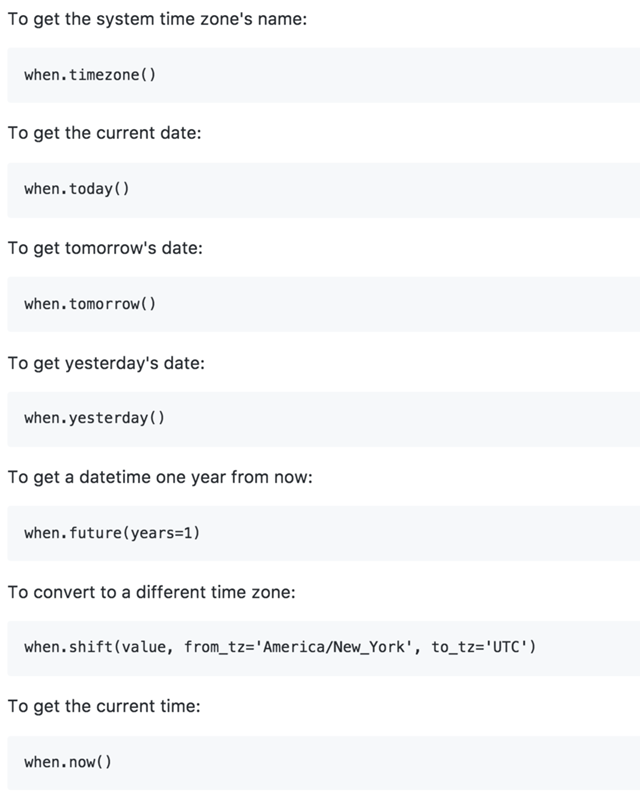在使用 Python 的开发过程中,除了使用 datetime 标准库来处理时间和日期,还有许多第三方的开源库值得尝试。
1、Arrow
Arrow 是一个专门处理时间和日期的轻量级 Python 库,它提供了一种合理、智能的方式来创建、操作、格式化、转换时间和日期,并提供了一个支持许多常见构建方案的智能模块 API 。简单来说,它可以帮你以更简便的操作和更少的代码来使用日期和时间。其设计灵感主要来源于 moment.js 和 requests 。
Quick start
- $ pip install arrow
- >>> import arrow
- >>> utc = arrow.utcnow()
- >>> utc
- <Arrow [2013-05-11T21:23:58.970460+00:00]>
- >>> utc = utc.replace(hours=-1)
- >>> utc
- <Arrow [2013-05-11T20:23:58.970460+00:00]>
- >>> local = utc.to(‘US/Pacific’)
- >>> local
- <Arrow [2013-05-11T13:23:58.970460-07:00]>
- >>> arrow.get(‘2013-05-11T21:23:58.970460+00:00’)
- <Arrow [2013-05-11T21:23:58.970460+00:00]>
- >>> local.timestamp
- 1368303838
- >>> local.format()
- ‘2013-05-11 13:23:58 -07:00’
- >>> local.format(‘YYYY-MM-DD HH:mm:ss ZZ’)
- ‘2013-05-11 13:23:58 -07:00’
- >>> local.humanize()
- ‘an hour ago’
- >>> local.humanize(locale=‘ko_kr’)
- ‘1시간 전’
2、Delorean
Delorean 提供了一个相比于 datetime 和 pytz 的更好的抽象,让你处理时间更容易。它有很多有用的处理时区的特性,标准化时区或者从一个时区改变到另外一个时区。
Quick start
- from datetime import datetime
- import pytz
- est = pytz.timezone(‘US/Eastern’)
- d = datetime.now(pytz.utc)
- d = est.normalize(d.astimezone(est))
- return d
- from delorean import Delorean
- d = Delorean()
- d = d.shift(‘US/Eastern’)
- return d
3、Pendulum
原生的 datetime 足够应付基本情况,但当面对更复杂的用例时,通常会有的捉襟见肘,不那么直观。 Pendulum 在标准库的基础之上,提供了一个更简洁,更易于使用的 API ,旨在让 Python datetime 更好用。
Quick start
- >>> import pendulum
- >>> now_in_paris = pendulum.now(‘Europe/Paris’)
- >>> now_in_paris
- ‘2016-07-04T00:49:58.502116+02:00’
- # Seamless timezone switching
- >>> now_in_paris.in_timezone(‘UTC’)
- ‘2016-07-03T22:49:58.502116+00:00’
- >>> tomorrow = pendulum.now().add(days=1)
- >>> last_week = pendulum.now().subtract(weeks=1)
- >>> if pendulum.now().is_weekend():
- … print(‘Party!’)
- ‘Party!’
- >>> past = pendulum.now().subtract(minutes=2)
- >>> past.diff_for_humans()
- >>> ‘2 minutes ago’
- >>> delta = past – last_week
- >>> delta.hours
- 23
- >>> delta.in_words(locale=‘en’)
- ‘6 days 23 hours 58 minutes’
- # Proper handling of datetime normalization
- >>> pendulum.create(2013, 3, 31, 2, 30, 0, 0, ‘Europe/Paris’)
- ‘2013-03-31T03:30:00+02:00’ # 2:30 does not exist (Skipped time)
- # Proper handling of dst transitions
- >>> just_before = pendulum.create(2013, 3, 31, 1, 59, 59, 999999, ‘Europe/Paris’)
- ‘2013-03-31T01:59:59.999999+01:00’
- >>> just_before.add(microseconds=1)
- ‘2013-03-31T03:00:00+02:00’
4、dateutil
dateutil 是 datetime 标准库的一个扩展库,几乎支持以所有字符串格式对日期进行通用解析,日期计算灵活,内部数据更新及时。
Quick start
- >>> from dateutil.relativedelta import *
- >>> from dateutil.easter import *
- >>> from dateutil.rrule import *
- >>> from dateutil.parser import *
- >>> from datetime import *
- >>> now = parse(“Sat Oct 11 17:13:46 UTC 2003”)
- >>> today = now.date()
- >>> year = rrule(YEARLY,dtstart=now,bymonth=8,bymonthday=13,byweekday=FR)[0].year
- >>> rdelta = relativedelta(easter(year), today)
- >>> print(“Today is: %s” % today)
- Today is: 2003-10-11
- >>> print(“Year with next Aug 13th on a Friday is: %s” % year)
- Year with next Aug 13th on a Friday is: 2004
- >>> print(“How far is the Easter of that year: %s” % rdelta)
- How far is the Easter of that year: relativedelta(months=+6)
- >>> print(“And the Easter of that year is: %s” % (today+rdelta))
- And the Easter of that year is: 2004-04-11
5、moment
用于处理日期/时间的 Python 库,设计灵感同样是来源于 moment.js 和 requests ,设计理念源自 Times Python 模块。
Usage
- import moment
- from datetime import datetime
- # Create a moment from a string
- moment.date(“12-18-2012”)
- # Create a moment with a specified strftime format
- moment.date(“12-18-2012”, “%m-%d-%Y”)
- # Moment uses the awesome dateparser library behind the scenes
- moment.date(“2012-12-18”)
- # Create a moment with words in it
- moment.date(“December 18, 2012”)
- # Create a moment that would normally be pretty hard to do
- moment.date(“2 weeks ago”)
- # Create a future moment that would otherwise be really difficult
- moment.date(“2 weeks from now”)
- # Create a moment from the current datetime
- moment.now()
- # The moment can also be UTC-based
- moment.utcnow()
- # Create a moment with the UTC time zone
- moment.utc(“2012-12-18”)
- # Create a moment from a Unix timestamp
- moment.unix(1355875153626)
- # Create a moment from a Unix UTC timestamp
- moment.unix(1355875153626, utc=True)
- # Return a datetime instance
- moment.date(2012, 12, 18).date
- # We can do the same thing with the UTC method
- moment.utc(2012, 12, 18).date
- # Create and format a moment using Moment.js semantics
- moment.now().format(“YYYY-M-D”)
- # Create and format a moment with strftime semantics
- moment.date(2012, 12, 18).strftime(“%Y-%m-%d”)
- # Update your moment’s time zone
- moment.date(datetime(2012, 12, 18)).locale(“US/Central”).date
- # Alter the moment’s UTC time zone to a different time zone
- moment.utcnow().timezone(“US/Eastern”).date
- # Set and update your moment‘s time zone. For instance, I’m on the
- # west coast, but want NYC’s current time.
- moment.now().locale(“US/Pacific”).timezone(“US/Eastern”)
- # In order to manipulate time zones, a locale must always be set or
- # you must be using UTC.
- moment.utcnow().timezone(“US/Eastern”).date
- # You can also clone a moment, so the original stays unaltered
- now = moment.utcnow().timezone(“US/Pacific”)
- future = now.clone().add(weeks=2)
6、When.py
提供对用户非常友好的特性来帮助执行常见的日期和时间操作。
Usage
